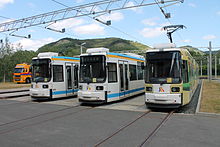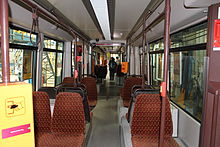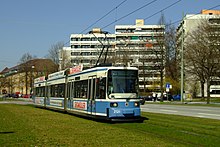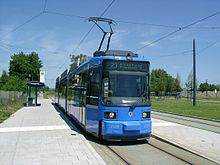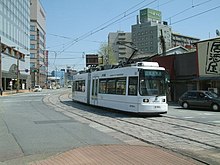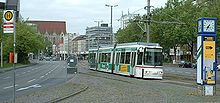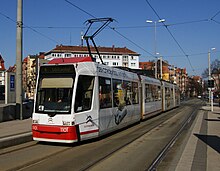GTxN / M / S
As GTxN / M / S / K ( G elenk- T railcars with x axes for N ormalspur / M eterspur / S chmalspur / K apspur) is a low-floor - tram referred -type of MAN and AEG was prepared and sold. In the following years the vehicles were produced by Adtranz and Bombardier . According to the basic technical concept, it is a low-floor short articulated trolley .
The standard gauge prototype was manufactured in 1989 by MAN / AEG for Bremen . Three more followed in 1990 (the first) and 1991 (the other two) for Munich . In 1993 the meter-gauge prototype was manufactured by MAN / AEG for Augsburg .
All vehicles manufactured by AEG in series production are factory-fitted with a lift or a wheelchair ramp .
The first vehicles were built in 1989, the last left the factory in 2009.
First generation
The well-known low-floor wagon type "Bremen" (GTxN / M / S) was developed in several steps as a derivative of the short articulated wagon developed by Hansa Waggonbau in Bremen in 1959 . At the end of the 1980s, the transport companies in Bremen and Munich were interested in further developing the short-articulated vehicle into a contemporary low-floor vehicle. There was no longer any interest in sidecars because they are not popular for safety reasons. In 1985 MAN GHH converted a Bremen articulated drive vehicle and an articulated trailer into the three-part test vehicle with the number 561. With this experience, the three-part prototype of the low-floor car type GT6N was then constructed at the end of the 1980s.
| GT4N-ZR / GT4K-ZR / GT6M / GT6M-ZR / GT6N / GT6N-ZR / GT6S / GT8N | ||||||
|---|---|---|---|---|---|---|
| Types: | GT4N-ZR | GT4K-ZR | GT6N / M / S | GT6N / M-ZR | GT8N | |
| Years of construction: | 1997-2009 | 2002-2006 | 1989-1997 | 1995-2003 | 1993-1996 | |
| Number: | 7th | 12 | 237 | 94 | 78 | |
| Manufacturer: | Adtranz , Niigata Transys | Bombardier, Niigata Transys | MAN , AEG , Adtranz, Bombardier | |||
| Car body length: | 18,550 mm | 18,000 mm (Okayama) 18,400 mm |
26,800 mm | 26,500 mm (N) 26,800 mm (M) |
35,400 mm | |
| Car body width: | 2,350 mm | 2,400 mm (Okayama) 2,450 mm |
2,300 mm | |||
| Car body height: | 3,390 mm | 3,047 mm | 3,290 mm | |||
| Floor height: | 350 mm | 360 mm | ||||
| Entry height: | 300 mm | |||||
| Wheel base: | 1,850 mm | |||||
| Wheel diameter: | 650 mm | 662 mm | ||||
| Seats: | 24 | 20 (Okayama) 30 |
58 (N) 62 (M) 60 (S) |
46, 50 * | 82-85 | |
| Standing room: | approx. 36 | 65 (Okayama) 50 |
87-97 | 97-104 | 123-132 | |
| Drive power: | 2 × 100 kW | 3 × 100 kW (N, M) 3 × 95 kW (S) |
3 × 100 kW | 4 × 84 kW | ||
| Top speed: | 70 km / h | |||||
| Weight: | 21,000 kg | 31,000 kg (N) 29,000 kg (M) 29,900 kg (S) |
31,500 kg (M) 31,600 kg (N) |
36,500 kg or 38,000 kg | ||
Meter gauge (GT6M)
| city | Facility type |
Zweirich- processing type |
total |
|---|---|---|---|
| Augsburg (GT6M) | 11 | 0 | 11 |
| Frankfurt (Oder) (GT6M) | 8th | 0 | 8th |
| Jena (GT6M-ZR) | 0 | 33 | 33 |
| Mainz (GT6M-ZR) | 0 | 16 | 16 |
| Zwickau (GT6M) | 12 | 0 | 12 |
| total | 31 | 49 | 80 |
GT6M in Augsburg
On January 29, 1993 a prototype ( MAN / AEG ) of the GT6M was delivered to Augsburg , which was given the number 601. It was approved for regular service by TÜV Süd on July 27, 1993 . Originally the prototype was supposed to be adapted to the series vehicles from Augsburg. But after the car had a serious accident in the front area on December 7, 1995, this project was discarded. The damage could have been repaired. However, it was decided to buy a replacement vehicle from series production. The prototype was then taken out of service and returned to the manufacturer in Nuremberg on December 23, 1995 . In 2001 the vehicle came to Siemens in Krefeld . The whereabouts of the vehicle are unknown. The Augsburg order was increased from ten vehicles to one vehicle on December 18, 1995, to eleven vehicles ( Adtranz ). The delivery of eleven vehicles had been completed by the end of October 1996. 611 was originally planned as a four-part, i.e. eight-axle vehicle (GT8M). However, this project was rejected.
GT6M in Frankfurt (Oder)
In September 1993 a railcar from Zwickau (the SVZ have twelve GT6M from MAN ) was on test drives in Frankfurt . In 1993 two railcars (TW) and in 1994 six railcars (Tw) were delivered (MAN / AEG ). From March 26, 1994 to April 25, 1994, car 303 was in Helsinki for test purposes . In 2004 the first vehicle (Tw 303) was repainted (lime green). More are to follow.
GT6M-NF in Zwickau
further information in the article Zwickau Tram
The GT6M have been in operation in Zwickau since 1993. In 1994, due to a vehicle derailing, all twelve vehicles had to be taken out of service until the cause was clarified. Otherwise, the SVZ operates the vehicles in Zwickau without further disruptions. Due to the signs of use, the Zwickau municipal transport company decided to modernize the twelve low-floor cars. In July 2019, railcar 907 was the first modernized car to arrive in Zwickau. Technical components were repaired or replaced with new ones, and the passenger compartment redesigned. In addition, adjustments to the accessibility in the vehicles were fed up. All vehicles will be modernized by the end of 2020. A deployment for at least another 16 years, max. 20 years of vehicles is planned. Jena and Frankfurt (Oder) tested the SVZ car 901 on their line networks in the 1990s.
GT6M-ZR in Jena
33 vehicles of the type GT6M-ZR are in use in Jena . Ten of them were built by AEG (601-610), nine more were built by Adtranz (No. 611-619) and 14 by Bombardier (No. 620-633). These railcars are bidirectional vehicles .
These vehicles were replaced by the Gotha and Rekowagen on July 12, 2003 after a service life of over 30 years. The first vehicle with the number 601 was delivered to Jena in 1995. In 1996, nine more vehicles followed. This completed the delivery from AEG. In 1997, the delivery of nine Adtranz vehicles followed. However, these were not enough to take the old Gotha and Reko cars (types ET 57 / EB 57 and TZ 70/1 / BZ 70/1 ) out of operation. In 2002 and 2003, Bombardier delivered.
Standard gauge (GT4N / GT6N / GT8N)
| city | Facility type |
Zweirich- processing type |
total |
|---|---|---|---|
| Berlin (GT6N / GT6N-ZR) | 105 | 45 | 150 |
| Bremen (GT8N) | 78 | 0 | 78 |
| Munich (GT6N / R2.2) | 70 | 0 | 70 |
| Norrkoping (GT6N) | 4 (1 ex Bremen 3 ex Munich) |
0 | 4th |
| Nuremberg (GT6N) | 14th | 0 | 14th |
| Kumamoto (GT4N-ZR) | 0 | 7th | 7th |
| total | 271 | 52 | 323 |
GT6N and GT6N-ZR in Berlin
On October 20, 1992, the framework conditions for the procurement of 120 trams were decided. The first car with the number 1001 was delivered to the Berliner Verkehrsbetriebe (BVG) on August 23, 1994 . Since there were problems with the first passenger deployments, the next scheduled deployment did not take place until November 14, 1994. The first series consisted of 29 one-way vehicles . The second series comprised 41 one-way trolleys. The third series consisted of 45 one-way cars and 15 two-way cars . The fourth series includes 30 bidirectional cars. The last car was delivered on April 2, 2003. The last series had the following changes compared to the previous deliveries:
- Air conditioning also for the passenger compartment
- tinted window panes in the passenger compartment
- raised roof panel around the entire car
- glass cab rear wall
- fully glazed doors
- LCD target display with cameras for video surveillance
- Sound-absorbing mats in the entire sub-floor area
- electrically height-adjustable foot switch in the driver's area
In February 2004 the Norrköping (Sweden) Berlin tram offered to buy five low-floor vehicles for 9 million euros, two of which would have been of the GT6N type and three of the GT6N-ZR type. Berlin refused the sale.
GT8N in Bremen
After a prototype of the type GT6N with the number 801 (later 3801) had already been in service since July 1990, it was decided to order 78 trams of the type GT8N. On October 9, 1993, the first four-part low-floor tram with the number 3001 arrived in Bremen. It was unveiled to the public a few days later on October 15th. The lift at the first door is striking . The delivery of the series dragged on until 1996. The vehicle with the number 3067 retired in 2001 due to an accident. The GT8N replaced the old Hansa cars and are used on all Bremen tram lines.
GT6N in Nuremberg
In October 1993, 14 GT6N railcars were ordered with an option for a further 26 cars. Delivery of the series was completed by the end of July 1996. In March and April 1997 the low-floor car 1010 was loaned to ADtranz; the middle part of the car was removed and replaced with two other parts. This resulted in a four-part vehicle in which a new type of joint design was tested for the successor GT8N2. VAG Nürnberg has been modernizing its tram cars since 2018, including the GT6N. The vehicles are given a new interior design and are technically brought up to date. Accessibility has also been improved.
GT6N in Munich
After the prototypes of the R 1.1 series (3 GT6N prototypes with the car numbers 2701 to 2703) had proven themselves, the series type R2.2 was developed from them. On March 31, 1992, the city of Munich ordered seventy GT6N with the car numbers 2101 to 2170. In May / June 1997 the vehicles were completely delivered.
GT4N in Kumamoto
In October 1996, Adtranz Germany, together with the Japanese company Niigata Transys, received the order to build two two-part low-floor railcars of the type GT4N for the tram operation of the city of Kumamoto . Adtranz manufactured the electrics / electronics and the bogies as well as the car body together with Niigata Transys. Mitsubishi Electric supplied the air conditioning system, and at the same time this company took over the service for Adtranz. The first low-floor tram in Japan arrived in Kumamoto on April 26, 1997 and has been in service since then under the local type designation 9700 形 (9700 series). In May 1998, two further motorcars of the same type were ordered from Adtranz. They have been in use since July 1999. On March 6, 2001, two more railcars arrived after a renewed order.
In 2009 another vehicle of the type GT4N-ZR (0800 形) was delivered. However, the new model differs fundamentally in its exterior and interior design from the original vehicles.
Cape gauge / 1100 mm gauge (GT4K / GT6S)
| city | Facility type |
Zweirich- processing type |
total |
|---|---|---|---|
| Braunschweig (GT6S) | 12 | 0 | 12 |
| Takaoka (GT4K-ZR) | 0 | 4th | 4th |
| Okayama (GT4K-ZR) | 0 | 1 | 1 |
| Toyama (GT4K-ZR) | 0 | 7th | 7th |
| total | 12 | 12 | 24 |
GT4K-ZR in Japan
After Niigata Transys and Adtranz had successfully delivered standard-gauge vehicles for the city of Kumamoto , GT4 trains in Cape gauge were manufactured for other Japanese cities . In 2002 a single vehicle was delivered to Okayama , which has been in use there as the "9200 形 MOMO" (MOMO = peach) series since then. Between 2003 and 2004 and 2006, Niigata Transys delivered four vehicles to Takaoka . In the same year, seven trains were delivered to Toyama . The design of the vehicles in the individual cities is individualized. In 2004 the Takaoka vehicle won the Japanese Good Design Award.
GT6S in Braunschweig
In June 1992, 12 GT6S were ordered. The first railcar was delivered on February 1, 1995, and the last arrived on August 18, 1995. Driver training on the twelve new low-floor railcars began on September 12, 1995. The first passenger deployment was on October 22, 1995. After a few technical problems, the railcars are running as planned.
Second generation
| GT8N2 | ||
|---|---|---|
| City: | Munich | Nuremberg |
| Designation: | R3.3 | GT8N |
| Years of construction: | 1999-2001 | 1999-2000 |
| Number: | 20th | 26th |
| Manufacturer: | Adtranz, Siemens | |
| Car body length: | 36,580 mm | |
| Car body width: | 2,300 mm | |
| Car body height: | 3,313 mm | |
| Floor height: | 360 mm | |
| Entry height: | 300 mm | |
| Wheel base: | 2,000 mm | |
| Wheel diameter: | 650 mm | |
| Seats: | 67 | 73 |
| Standing room: | 151 | 145 |
| Drive power: | 4 × 120 kW = 480 kW | |
| Top speed: | 70 km / h (limited to 60 km / h) |
|
| Weight: | 40,800 kg | 40,400 kg |
The experience that was made with the first generation vehicles (GTxN / M / S) in the mid-1990s led to the conception of a revised version called the GT8N2. The main requirements that were incorporated are:
- Cost minimization through
- Reduction of interfaces in the mechanical part between shell construction, expansion and equipment as well as between mechanical part and electrical equipment
- consistent standardization
- lighter materials
- more modern, functional and customer-oriented design
- additional kink protection when driving in a straight line
- Improved envelope curve and protection against climbing for four-part vehicles in businesses with tight track radii and S-curves
In the design, the redesigned, angular front is striking, with a target box that is separated from the front pane and inclined slightly forwards, which reduces the glare effect. The front and other elements can be freely designed according to customer requirements. The modified bogie construction made it possible to increase the legroom between the seats from 475 mm to at least 600 mm. To reduce weight, the classic welded steel construction was switched to an aluminum hybrid construction.
With the type GT8N2 you have technically arrived at the old principle of the articulated car with articulated sidecar, but with the difference in passenger-friendly transitions. The easy separation of the two halves of the car makes maintenance easier.
| city | Facility type |
Zweirich- processing type |
total |
|---|---|---|---|
| Munich (R3.3) | 20th | 0 | 20th |
| Nuremberg (GT8N) | 26th | 0 | 26th |
| total | 46 | 0 | 46 |
GT8N2 in Munich
On February 13, 1996, the city council decided to purchase 17 GT8N2 railcars. In February 1997 this order was increased to 20 railcars. The first GT8N2 multiple unit arrived on December 10, 1999. The GT8N2 have been in daily use since February 14, 2000. The series was completely delivered in October 2001.
GT8N2 in Nuremberg
On November 28, 1998, the first two four-part GT8N2 low-floor wagons came to Nuremberg . Adjustment and test drives were carried out until the end of February 1999, after which they were returned to the Adtranz manufacturing plant for completion work. Since their gradual delivery in March 1999, all vehicles have been in regular service.
Individual evidence
- ↑ a b Tram magazine 08/14. (No longer available online.) Archived from the original on April 5, 2015 ; accessed on August 24, 2015 . Info: The archive link was inserted automatically and has not yet been checked. Please check the original and archive link according to the instructions and then remove this notice.
- ↑ AEG GT6M. Retrieved October 18, 2018 .
- ↑ Home. Retrieved October 18, 2018 .
- ↑ AG tram-info: Welcome to www.tram-info.de. Retrieved October 18, 2018 .
- ↑ Railcar 801 return. Accessed August 31, 2019 .
- ↑ Like new: the first tram is modernized and back in Nuremberg. Verkehrsaktiengesellschaft Nürnberg (VAG), accessed on February 25, 2019 .
- ↑ Archive link ( Memento of the original dated December 6, 2004 in the Internet Archive ) Info: The archive link was inserted automatically and has not yet been checked. Please check the original and archive link according to the instructions and then remove this notice.
literature
- Stadtverkehr magazine "100 years of trams in Jena - a history with a future"
Web links
- Photos of the GT6 NF + GT 8 NF from Berlin, Munich, Nuremberg and Augsburg
- Technical data - AEG / ADtranz / Bombardier GT6N / M / S, GT6M-ZR & GT6N-ZR. In: Strassenbahn-Online.de. Retrieved October 17, 2012 .

